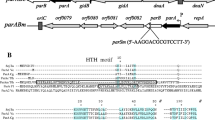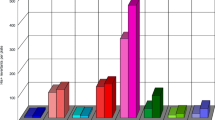Summary
Several conditional-lethal mutations that do not permit the replication of F-factors ofEscherichia coli K-12 are located at a site calledseg. This gene is located on theE. coli chromosome betweenserB andthr. It is unrelated to other known genes involved in DNA replication. Strains carryingseg mutations were unable to replicate F′-lac+, several F′-gal+s, F′-his+ and bacteriophage λ at 42°. However, neither phage T4, ColE1, nor any of the R factors tested were prevented from replicating at 42°C.
When the kinetics of the loss of F-primes is studied inseg strains, it is found that the rate of curing depends on the size of the plasmid, larger F factors curing faster than smaller ones, and that Hfrs are formed at high frequencies. The Hfrs showed both F-genote enlargement and normal transfer of chromosomal markers. The F-genotes are unstable and segregate chromosomal markers at high frequencies. Some orthodox Hfrs were examined, and two that were known to revert to the F+ condition relatively frequently were found to generate enlarged F-genotes on mating, whereas two strains that were very stable with respect to reversion to the F+ state did not show F-genote formation.
F-genote formation fromseg Hfr strains is dependent of a functionalrecA gene, as F-genote formation was not seen with aseg-2, recA-1 Hfr. This is in contrast to F-genote enlargement shown by both orthodox Hfrs and an Hfr strain constructed by integration of a temperature-sensitive F′-gal+, whose F-genote enlargement is Rec-independent. Thus there may be more than one mechanism for the formation of enlarged F-genotes.
Similar content being viewed by others
References
Adelberg, E.A., Bergquist, P.: The stabilization of episomal integration by genetic inversion: a general hypothesis. Proc. nat. Acad. Sci. (Wash.)69, 2061–2065 (1972)
Bergquist, P.L., Adelberg, E.A.: Abnormal excision and transfer of chromosomal segments by a strain ofEscherichia coli K12. J. Bact.111, 119–128 (1972)
Broda, P., Meacock, P.: Isolation and characterisation of Hfr strains from a recombination-deficient strain ofEscherichia coli. Molec. gen. Genet.113, 166–173 (1971)
Cress, D.E., Kline, B.C.: Isolation and characterization ofEscherichia coli chromosomal mutants affecting plasmid copy number. J. Bact.125, 635–642 (1976)
Cuzin, F., Jacob, F.: Mutations de l-épisome F d'Escherichia coli K12. II-Mutations à réplication thermosensible. Ann. Inst. Pasteur112, 397–418 (1967)
Datta, N., Hedges, R.W., Shaw, E.J., Sykes, R.B., Richmond, M.H.: Properties of an R-factor fromPseudomonas aeruginosa. J. Bact.108, 1244–1249 (1971)
Filip, C.C., Allen, J.S., Gustafson, R.A., Allen, R.G., Walker, J.R.: Bacterial cell division regulation: characterization of thednaH locus ofEscherichia coli. J. Bact.119, 443–449 (1974)
Goebel, W., Schrempf, H.: Replication of plasmid DNA in temperature-sensitive DNA replication mutants ofEscherichia coli. Biochim. biophys. Acta (Amst.)262, 32–41 (1972)
Hathaway, B.G., Bergquist, P.L.: Temperature-sensitive mutations affecting the replication of F-prime factors inEscherichia coli K12. Molec. gen. Genet.127, 297–306 (1973)
Hirota, Y., Ryter, A., Jacob, F.: Thermosensitive mutants ofE. coli affected in the process of DNA synthesis and cellular division. Cold Spr. Harb. Symp. quant. Biol.33, 677–693 (1968)
Hu, S., Ohtsubo, E., Davidson, N.: Electron Microscope heteroduplex studies of sequence relations among plasmids ofEscherichia coli: Structure of F13 and related F-primes. J. Bact.122, 749–763 (1975)
Jacob, F., Brenner, S., Cuzin, F.: On the regulation of DNA replication in bacteria. Cold Spr. Harb. Symp. quant. Biol.28, 329–348 (1963)
Kingsbury, D.T., Helinski, D.R.: Temperature-sensitive mutants for the replication of plasmids inEscherichia coli. I. Isolation and specificity of host and plasmid mutations. Genetics74, 17–31 (1973)
Kopecko, D.J., Cohen, S.N.: Site-specificrecA-independent recombination between bacterial plasmids: Involvement of palindromes at the recombination loci. Proc. nat. Acad. Sci. (Wash.)72, 1373–1377 (1975)
Low, B.: Rapid mapping of conditional and auxotrophic mutations inEscherichia coli K-12. J. Bact.113, 798–812 (1973)
Low, K.B.:Escherichia coli K-12 F prime factors, old and new. Bact. Rev.36 587–607 (1972)
Meynell, E., Cooke, M.: Repressor-minus and operator-constitutive derepressed mutants of F-like R factors: their effect on chromosomal transfer by HfrC. Genet. Res.14, 309–313 (1969)
Miller, J.H.: Experiments in molecular genetics. Cold Spring Harbor, N.Y.: Cold Spring Harbor Laboratory (1972)
Novick, R.P.: Studies on plasmid replication. III. Isolation and characterization of replication-defective mutants. Molec. gen. Genet.135, 131–147 (1974)
Ozeki, H., Stocker, B.A.D., Smith, S.M.: Transmission of colicinogeny between strains ofSalmonella typhimurium grown together. J. gen. Microbiol.28, 671–687 (1962)
Paul, A.V., Inouye, M.: Temperature-sensitive modification and restriction phenotypes of anEscherichia coli dnaD mutant. J. Bact.119, 907–912 (1974)
Saedler, H., Heiß, B.: Multiple copies of the insertion sequences IS1 and IS2 in the chromosome ofE. coli K12: Molec. gen. Genet.122, 267–278 (1973)
Sharp, P.A., Hsu, M-T., Ohtsubo, E., Davidson, N.: Electron microscope heteroduplex studies of sequence relations among plasmids ofEscherichia coli. I. Structure of F-prime factors. J. molec. Biol.71, 471–497 (1972)
Stadler, J., Adelberg, E.A.: Temperature dependence of sex factor maintenance inEscherichia coli K-12. J. Bact.109, 447–440 (1972)
Taylor, A.L., Trotter, C.D.: Linkage map ofEscherichia coli strain K-12. Bact. Rev.36, 504–524 (1972)
Uhlin, B.E., Nordström, K.: Plasmid incompatibility and Control of replication: copy mutants of the F-factor R1 inEscherichia coli K-12. J. Bact.124, 641–649 (1975)
Wechsler, J.A.: Genetic and phenotypic characterization ofdnaC mutations. J. Bact.121, 594–599 (1975)
Willetts, N.: The genetics of transmissible plasmids. Ann. Rev. Genet.6, 257–268 (1972)
Author information
Authors and Affiliations
Additional information
Communicated by O. Siddiqi
Rights and permissions
About this article
Cite this article
Jamieson, A.F., Bergquist, P.L. Plasmid replication and Hfr formation in strains ofEscherichia coli carryingseg mutations. Molec. Gen. Genet. 150, 171–181 (1977). https://doi.org/10.1007/BF00695397
Received:
Issue Date:
DOI: https://doi.org/10.1007/BF00695397




